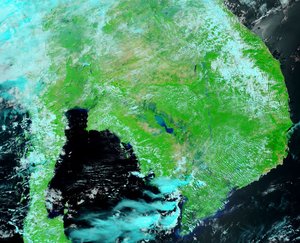Monsoon
|
|
A monsoon is a periodic wind, especially in the Indian Ocean and southern Asia. The word is also used to label the season in which this wind blows from the southwest in India and adjacent areas that is characterized by very heavy rainfall, and specifically the rainfall that is associated with this wind.
| Contents |
History
The word "monsoon" appears to have originated from the Arabic word "موسم" (mausem), which means season. It is most often applied to the seasonal reversals of the wind direction along the shores of the Indian Ocean, especially in the Arabian Sea, that blow from the southwest during one half of the year and from the northeast during the other.
The legendary Greek sailor Hippalus was traditionally held to have been the first to use the monsoon to speed across the Indian Ocean; the ancient name for the monsoon wind in this region is also called Hippalus. However, it is more likely that he was simply the first Greek to master the monsoon, as Yemeni sailors were trading with India long before his time.
Processes
Monsoons are caused by the fact that land heats up and cools down quicker than water. Thus, in summer, land reaches a higher temperature than the ocean. Air thus rises over the land. This causes an area of low pressure. Since wind blows from areas of high pressure to areas of low pressure, an extremely constant wind blows from the ocean. The rainfall is caused by the moist air rising up mountains and cooling.
In winter, since the land cooled down quickly, the ocean is thus warmer. Air then rises, causing a low over the ocean. The wind then blows back out over the ocean. Since the temperature difference between the ocean and land is less than in summer, this wind is not as constant.
Monsoons are therefore similar to sea breezes, but they are much larger in scale, stronger, affect a wider area, and are more constant.
Monsoon Systems
As monsoons have come to be better understood, the definition has been broadened to include almost all of the phenomena associated with the annual weather cycle within the tropical and subtropical continents of Asia, Australia, and Africa and the adjacent seas and oceans. It is within these regions that the most vigorous and dramatic cycles of weather events on Earth takes place.
Even more broadly, in the geological past, it is now understood, monsoon systems must have always accompanied the formation of supercontinents such as Pangea, with their extreme continental climates.
North American Monsoon
The North American monsoon occurs from mid July into September and affects Arizona, New Mexico, Nevada, Utah, Colorado, and California. It pushes as far west as the Peninsular Ranges and Transverse Ranges of southern California but rarely reaches the coastal strip (a wall of desert thunderstorms only a half-hour's drive away is a common summer sight from the sunny skies along the coast). The North American monsoon is associated an area of high pressure called the subtropical ridge that moves northward during the monsoon season. At the surface, the monsoon is associated with a weak high that forms over the four corners region and a thermal low that forms over the Colorado River valley. The Bermuda high also plays some role in the monsoon. The placement of the high and low pressure areas causes the wind to shift from westerly to southerly. Moisture is drawn northward from the Gulf of California into northern Mexico and the Southwest United States. Rainfall during the monsoon occurs as thunderstorms over the southern Rocky Mountains and adjacent areas. This season of almost daily thunderstorms is often called the Southwest, Mexican or Arizona monsoon. It is also sometimes called the Desert Monsoon as a large part of the affected area is desert. As much as 70% of rainfall in the region occurs during the summer monsoon season. Many desert plants are adapted to take advantage of this wet season in the usually-dry area. Because of the danger of being caught in the open when these storms suddenly appear, many golf courses in Arizona have thunderstorm warning systems.
North-east Winter Monsoon
The north-eastern winter monsoons take place from December to early March. The temperature over central Asia is lower, creating a zone of high pressure there. The jet stream splits into two, one southern subtropical jet and the polar jet. The sub-tropical jet directs north-easterly winds to blow across south Asia creating dry air streams which produce clear skies over India from the months of November to May.
Meanwhile, a low pressure system develops over northern Australia and winds are directed towards Australia.
During the NE winter monsoon, Australia and south-east Asia receive large amounts of rainfall.
South-west Summer Monsoon
The South-western summer monsoons occur from June to September, after the winds shift during the months of March and May. An area of intense low pressure develops over central Asia, and the jet stream blows over this area.
The south-eastern winds blow towards the area of low pressure over Asia, passing over south-east Asia, which experience large amounts of rainfall in this period. Meanwhile, the south-west monsoon is drawn towards the Himalayas, creating winds blowing rain clouds towards India, which receive up to 10,000 mm of rain in some areas.

